In this guide, we are going to take you through the entire step-by-step process that you need to be following to build out a monthly SEO report that will work for you, whether you’re:
- Working for a company as a member of their in-house team.
- Working for a marketing agency.
- Acting as a freelancer.
It’s regular SEO reporting that can help you achieve results like this:
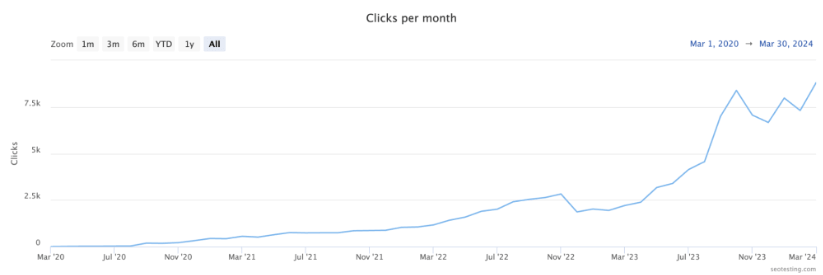
We will also discuss what an SEO report is, the benefits of utilizing monthly SEO reports within your business practices, and what an excellent monthly SEO report should contain.
So let’s get into it.
What is an SEO Report?
An SEO report is a document or presentation that compiles data and analyzes a website’s performance within the SERPs. It will detail key aspects of your website’s performance, including your current keyword rankings, organic traffic, click-through rates, and website backlink profile.
When done correctly, it will assess how well your website adheres to the various best practices of SEO, highlighting areas where it is doing well and areas that need improvement.
Your SEO report, no matter the cadence at which it is performed, is an excellent snapshot of your website’s organic performance and visibility at that time.
What are the Benefits of Using Monthly SEO Reports?
When it comes to your SEO reports, we recommend working to a monthly cadence, as this has many benefits. In this section, we will explain those benefits.
Find What’s Working & What’s Not
Completing monthly SEO reports allows you to track your website’s performance over time. This gives you a detailed view of what strategies are working well and which areas require additional attention.
By consistently monitoring data such as:
- Keyword rankings
- Organic traffic
- User engagement metrics
- Conversion rates
You can identify trends and patterns that can then be used to modify your SEO strategy. For example, if you notice content decay on specific keywords, it might show you that you need a content refresh. On the other hand, if you see an increase in traffic following content updates, then you are in a good position to suggest that what was done was successful, and you can keep doing this across other areas of your website.
This ongoing evaluation allows you to monitor, tweak, and improve your SEO strategy over time.
Easily Measure Performance
Monthly SEO reporting is excellent as it provides a structured framework to systematically track your website’s performance, allowing for easy measurement of key metrics such as traffic, rankings, backlinks, and user engagement.
This regular reporting process captures data over a period that is long enough to allow you to identify trends when needed and short enough for you and your stakeholders to pivot if necessary. As we all know, successful SEO campaigns sometimes require change when someone notices a moving goalpost, so being adaptable is vital. Monthly SEO reporting allows you this freedom to move with the goalposts.
Establishing a consistent timeline for your reporting makes it much easier to gauge the impact of your work and adjust your strategies and tactics accordingly. This methodical approach ensures that your website performance isn’t just monitored but well managed to support ongoing improvements.
Measure Competitor Performance Easily
Your SEO reports will focus on your website’s performance and your competitors’ strategies, allowing you to stay ahead of them or adapt where needed.
Tools like Ahrefs and Semrush play a crucial role, providing features that help you track your competitors’ keyword rankings, backlink profiles, and content updates. These reports allow you to monitor shifts in your competitors’ tactics, find out what keywords they are targeting, and find new backlink opportunities for your website.
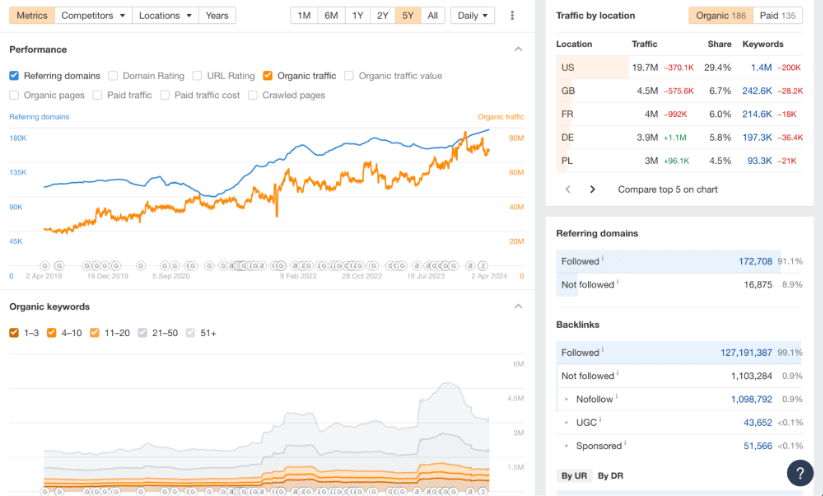
This constant monitoring allows you to benchmark your performance against theirs and modify your SEO strategies to either capitalize on gaps in their performance or see their approaches that work and take advantage of these yourself.
By integrating competitor analysis into your monthly SEO reporting, you can ensure that your SEO strategy is optimized for search engines and competitive within your industry. This will help you maintain or improve your market position.
Monitor Technical SEO Status
Creating SEO reports every month is crucial for monitoring your website’s technical SEO performance and ensuring that it remains accessible, fast, and easy for search engines to crawl.
Using site crawling tools like ScreamingFrog or Sitebulb can help to no end in this process by automating the process of finding technical issues like:
- Broken links
- Improper redirects
- Pages that are slow to load
- Problems with your sitemap
- Problems with your robots.txt files
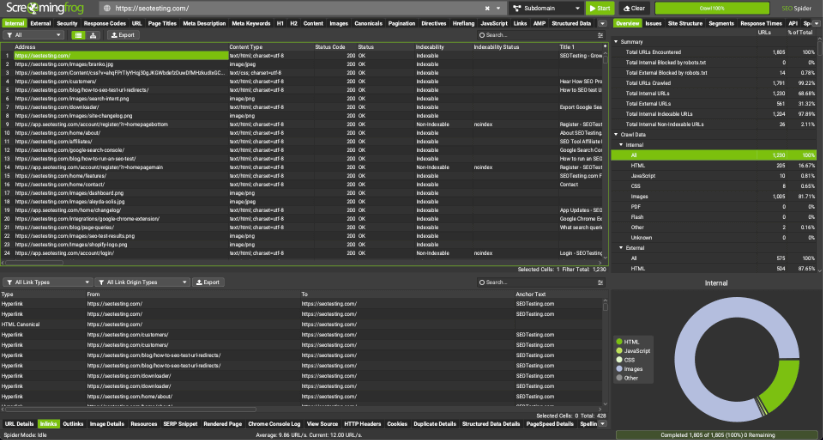
These tools, and others, offer a comprehensive view of your site’s technical health, allowing you to find and fix problems that could impact search engine performance and, more importantly, user experience.
Adding findings from these crawlers to your monthly SEO reports allows you to easily track improvements over time, prioritize fixes based on their impact, and ensure that technical SEO remains a pillar of your overall strategy.
Evaluate Return on Investment
Monthly SEO reports play a vital role in evaluating the ROI you’re seeing from your SEO campaigns by providing a clear, data-driven snapshot of how the work you’re doing translates into actual business outcomes.
These reports include your business’s KPIs, including organic traffic, conversion rates, and keyword rankings, alongside the costs associated with implementing SEO strategies. By simply comparing the revenue generated from organic search traffic against the investment you have made in your SEO activities, you can determine your ROI.
This regular analysis allows you to adjust your strategy to focus on high-performing areas, reducing any spending on less effective tactics. Overall, this will help you and your team correctly show the value of your hard work to stakeholders and peers!
What Should an SEO Report Contain?
Of course, what your monthly SEO report contains will depend on what you are required to report on, what industry you’re in, and what KPIs you have as an SEO team, but some things remain the same across industries and teams.
With that in mind, we’ve dedicated this section to showing you what your monthly SEO reports should all contain.
Information on KPIs
All good SEO reports, monthly or not, will have information on the KPIs the SEO team is working towards.
For some businesses, this will be pretty simple and focus on metrics like the organic traffic your website is getting, the number of website leads you are attracting from your organic traffic, having specific keywords at certain positions, and your organic CTR.
For other businesses, there may be more nuance to this. Some SEO teams may need to include conversion rates (especially if they are an e-commerce business) or report on traffic from a specific section of visitors, such as mobile traffic.
Whatever KPIs you, as an SEO team, need to report on, it’s essential to include a section at the top of your SEO report to show the rest of the business what you are working towards.
Ranking Information
I’ve worked in SEO for nearly nine years. During that time, I have completed hundreds (if not thousands) of SEO reports, including information on where the business currently ranks for specific keywords.
Every business has keywords that they are actively targeting. For some, the keywords might be at the very top of the funnel, and others may put a lot of time, money, and energy into ranking for keywords at the bottom. Whatever the target keywords area, your SEO report must show how you are doing with these keywords.

This is going to stay consistent as time goes on. We have moved away from the traditional ‘Page 1’ and ‘Page 2’ reporting style because Google has actively switched to infinite scrolling, but keyword rankings are still around, and they will be around (in my opinion) for years to come.

Traffic from Different Sources
I believe including traffic from different sources in a monthly SEO report is essential because it provides a comprehensive overview of a website’s overall performance and the effectiveness of various marketing strategies.
You can argue that the SEO team shouldn’t focus on traffic from different sources, but I disagree.
By analyzing traffic from direct visits, referrals, social media, and paid advertising, you can understand how different channels contribute to your site’s visibility and user engagement.
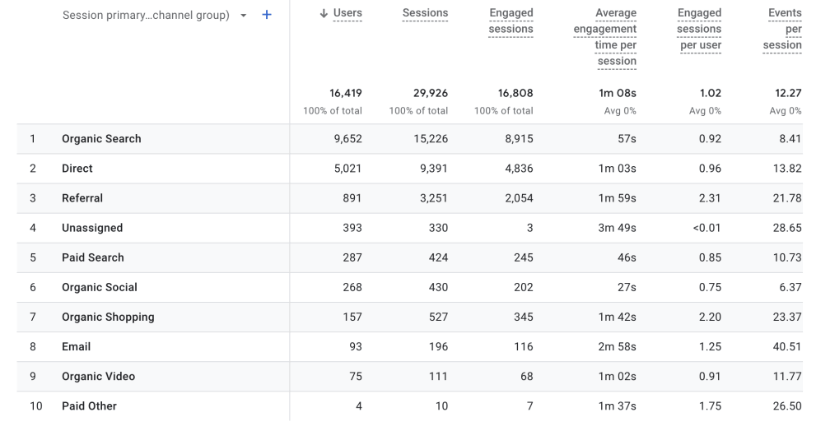
For example, if you notice a spike in referral traffic, it could mean that your link-building efforts are paying off. Or an increase in social media traffic could mean that the content marketing work you are completing is working well.
Additionally, understanding the distribution of traffic sources helps you to allocate resources more effectively, optimize strategies across channels, and ensure that all SEO efforts are aligned with broader marketing objectives.
Report on Backlinks
No matter what is being said online, within other marketing teams, and across the web more generally, backlinks still play a massive role in moving the needle for your website. In my opinion, they’re still the number one thing that helps Google’s algorithms establish how authoritative your website is for different search queries, so they’re still hugely important.
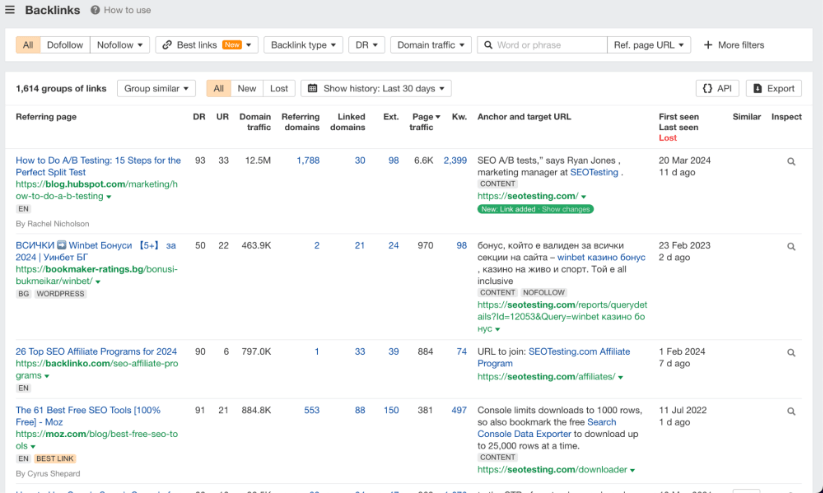
Because of that, it’s worth adding a short report on backlinks in all of your monthly SEO reports.
You can do this in several ways, but I’d recommend the following:
- Add a section showing the new backlinks you acquired for that month.
- Adding in any backlinks you have lost over the month.
- Including information on competitor backlinks is also helpful.
This way, your stakeholders can see what has been working regarding off-page SEO initiatives, like backlink acquisition, what has not, and where your competitors are performing well. This information can all be used to modify your approach for the next month.
General SEO Health
Including a section on a website’s general SEO health within a monthly SEO report is vital because it provides a snapshot of your website’s performance in search engines at a foundational level.
This section assesses the website’s compliance with SEO best practices, covering aspects such as site structure, page speed, mobile-friendliness, indexability, and content quality. By regularly evaluating these factors, you can identify and address technical issues, content gaps, and UX problems that may negatively impact search engine visibility and user engagement.
Focusing on SEO health keeps your website on a strong foundation, allowing you to build more effective SEO strategies. It helps identify areas for improvement, which, once addressed, can greatly enhance your site’s performance in search engine results pages.
This proactive approach to maintaining SEO health will not only support your website’s ability to rank well in general, but it will also enhance the experience users have on your site, which will (over time) lead to higher conversion and engagement rates.
Check the SEO checklist article for a complete list of things that will help optimize your website and eventually lead to better rankings.
How to Create a Monthly SEO Report?
In this next section, we will explain how to build your own monthly SEO report, covering each important step as we go.
Step 1: Establish KPIs
The first step of any good monthly SEO report is to establish the KPIs you will be working towards. These will be different depending on your unique situation. Marketing agencies working for clients will have different KPIs than in-house employees, who will also have different KPIs than freelancers.
So, we have outlined some popular KPIs for each discipline, but feel free to amend these to include what’s helpful in your situation.
Reporting KPIs for Marketing Agencies
Marketing agencies will often report on a whole host of SEO KPIs to show the effectiveness of their SEO strategies to clients. These KPIs often include:
- Organic traffic
- Keyword rankings
- Conversion rates
- Click-through rates
- Backlink profiles
- Engagement rates
- Page load time
- Mobile usability
- Top performing pages
Tracking these metrics allows agencies to provide actionable insights, celebrate client wins, and pinpoint areas for improvement in the months following the report. It is crucial to note that any KPIs included in the monthly SEO report will align closely with the client’s business goals.
Reporting KPIs for In-House Employees
In-house teams generally prioritize a tailored set of KPIs, which all depend on the industry in which they work, the size of the company where they operate, and the specific website type they are working on. Some KPIs which might be tracked by in-house staff include:
- Organic traffic
- Keyword rankings
- Conversion rates from organic search
- The number of internal links to important pages
- Technical SEO health
- Content gap analysis
These KPIs, and others, allow in-house teams to refine their SEO strategies over time, focusing on improving website performance and alignment with the company’s overall business objectives.
Reporting KPIs for Freelancers
Freelancers specializing in SEO often track a distinct set of KPIs tailored to each client. All of the measured KPIs will be there to show the impact of their work and help justify the value they bring to clients. Generally, these KPIs include:
- Organic traffic, naturally
- Keyword rankings
- Client-specific conversion rates
- Backlink quality
- Local SEO performance
- Client ROI
Freelancers use these KPIs to align their SEO strategies with each client’s business goals. This helps them provide clear, measurable results that demonstrate the efficacy and value of their work.
Step 2: Choose the Correct Layout
Once all your KPIs have been chosen, the next step is determining the layout that best suits your new monthly SEO reports.
Depending on the company, you have several different options. You might choose to report in spreadsheet format; some people/teams may want to report via slide decks, and others may even wish to build custom reports using a tool such as Google Looker.
Spreadsheets
Writing a monthly SEO report in a spreadsheet format is especially useful for SEOs with a technical SEO and data analysis background who appreciate the ability to dive deep into raw data!
This format allows for detailed tracking of KPIs, changes over time, and nuanced data analysis using formulas and pivot tables. Spreadsheets allow you to look at SEO performance on a granular level, enabling users to manipulate data in various ways to uncover trends, anomalies, and opportunities for optimization.
This method is suitable for anyone who wants to conduct in-depth analysis, create custom calculations, or share data with stakeholders who want to interact with and draw conclusions directly from the data.
Slides
Slide deck formats are ideal for SEO managers and consultants who must communicate their monthly SEO report findings to clients or non-technical team members.
Slide decks allow the presenter to convert complex information into visually appealing, easy-to-understand summaries.
Focusing on key metrics, significant achievements, and areas needing attention, this format allows for clear storytelling and helps audiences who may not be familiar with SEO’s various intricacies understand. The use of visuals, charts, and bullet points in slide decks will help highlight successes and next steps, making it easier to align the strategy going forward.
Custom-Built Reports
A custom-built report format will suit SEO specialists or agencies aiming to provide a tailored reporting experience for their clients.
This approach allows for branding reports, integrating various data sources, and creating a narrative that closely aligns with the client’s specific goals, needs, and concerns.
Custom-built reports can offer interactive elements, such as live data feeds, clickable content, and personalized dashboards, enhancing the client’s experience with the data. This personalized reporting method shows that you are offering a high level of service and that you understand the client’s unique needs, which will help foster a strong relationship in the long run.
Step 3: Build your Monthly SEO Report
The next step is to start building your monthly SEO report.
Start by collecting data from various sources, such as Google Analytics, Google Search Console, and external SEO tools like Ahrefs, Semrush, and SEOTesting.
This step involves gathering information on your chosen KPIs. Once collected, you can start putting all of this data into your chosen reporting format – be it a spreadsheet, slide deck, or custom-built report – carefully organized to highlight important metrics and trends.
Step 4: Make Recommendations Based on Findings
The recommendations you make based on the findings of your SEO report are crucial for driving the SEO strategy forward. Your report will not only show off the successful aspects of your efforts, but it will also highlight areas that require improvement.
By focusing on these improvement areas and using the data gathered to help flesh out your recommendations, you can offer strategic insights for optimizing your site’s SEO performance.
Whether it is suggesting content updates, technical fixes, or a shift in keyword strategy, your recommendations should address the specific challenges and opportunities identified in the report. This approach ensures that your SEO efforts are continually refined and targeted towards achieving the best possible outcomes.
Step 5: Run the Report Consistently
Running the report consistently and adhering to a monthly cadence is essential for tracking SEO performance and website health.
Regular reporting will not only help you track the immediate impact of SEO actions but also help identify longer-term trends and patterns that may not be apparent in a short timeframe. This consistency allows you to measure the progress you are making against goals and benchmarks, allowing you to create a strategic and data-driven approach to SEO.
By regularly reviewing and analyzing these reports, you can adjust your strategy, capitalize on what works, and correct course where needed.
The ‘Quick Win’ Monthly SEO Report
The End of Month Report within SEOTesting is an easy and fast way of viewing the essential website data.
You can find it within the Winners & Losers reports section in your SEOTesting account.
Using it, your in-house monthly reporting is much easier, your agency client reporting takes less time, and if you run your websites, you might just be jumping for joy at the end of each month.
With the click of a button, you will see a month-on-month, plus a year-on-year, view of your website based on Google Search Console data:
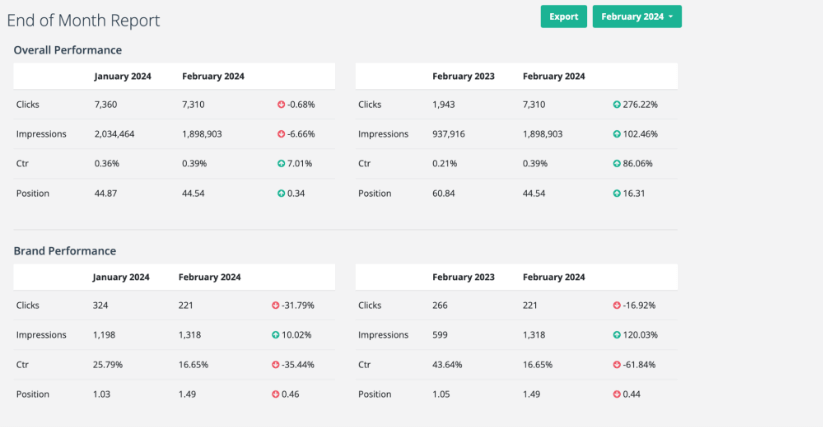
But not only that… If you have set up a brand keywords regex within your website settings in SEOTesting, we will split the overall site performance into a brand vs non-brand report.
There is lots of other useful information within the report, including:
- Overall site month vs month and year vs year.
- Top 20 queries & top 20 URLs.
- Query winners by clicks.
- Query losers by clicks.
- Page winners by clicks.
- Page losers by clicks.
- Top 20 new pages.
- Top 20 new queries.
This is a sure-fire way to make your monthly SEO reporting easier!

Wrapping Up
Crafting a comprehensive and practical monthly SEO report is critical for SEO professionals across the board, whether you’re an in-house team member, part of a marketing agency, or a freelancer.
This guide has walked you through the essential steps to build a report that tracks and measures the performance of your SEO efforts and provides actionable insights and strategic recommendations based on data-driven analysis.
From establishing relevant KPIs and choosing the proper format to making informed recommendations and ensuring consistency in your reporting cycle, the process demands attention to detail and a strategic mindset.
Remember, the ultimate goal of your monthly SEO report is to demonstrate the value of SEO activities, highlight areas for improvement, and guide your future strategies to enhance visibility, drive traffic, and improve conversions. By following these guidelines, you can create reports that are informative and instrumental in achieving sustained SEO success.
SEOTesting can help with your monthly SEO reporting! We make GSC data more accessible to you, creating custom reports based on your GSC data and our know-how for SEO testing. Try us out with our 14-day free trial now.

